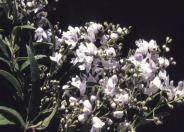
Common name:Victorian Christmas Bush
Botanical name:Prostanthera lasianthos
A tall, graceful forest shrub (to small tree), highly variable in its habit and appearance. It ranges from a 32' high tree growing in sheltered forest to a 6' high shrub growing in exposed montane areas. It is the largest member of the genus Prostanthera. It can be found growing by creeks and in the moist shade of dense, wet sclerophyll forests in Queensland, NSW, Victoria and Tasmania. In NSW, it grows all along the coastal and tablelands divisions and moved into the north-western slopes, from low to high altitude, in dry sclerophyll woodland and forest and well as wet sclerophyll forest to rainforest edged. They can be found as large plants on the headwaters of the Hawkesbury/Nepean River around Kangaloon, NSW, where at first glance, they resemble small willow trees. Bark is green to dark brown to blackish, shallowly fissured longitudinally. Stems square. In large plants, the stem can be up to 5" diameter at the base. Leaves in opposite pairs (rarely in 3-leaf whorls) on tiny petioles. They are dark green to green-grey, lanceolate to ovate, to 5" long and to 1" wide, and tapering to an acute apex. The leaf undersurface is paler. Leaves vary a lot in their shape, size and toothing. Flowers have a shape described as labiate (applies to all Lamiaceae flowers) with 5 petals varying in their size, fused at their base, produced in leaf axils. One of the identification features for Prostanthera is that the 5 calyx parts (basal whorl of the flower) are fused into 2 lips. In this species, tiny flowers are white to pale mauve or bluish with purple to mauve spots in the throat, with a bell-shaped tube. Flowers are produced in large open terminal panicles, occurring from November to March. Fruits – 4 tiny nutlets (mericarps) produced at the base of the calyx.
In a garden situation, with a good mulch and some watering, it is fast growing and will grow in light or stiff soils in sun or shade, but constant wind should be avoided. It is also tolerant of light frost and snow. It is excellent for hiding a fence or as a tall hedge. Plants will tolerate some enrichment from organic matter. Can be used to great effect with other shrubs and can likely tolerate heavier pruning than most of its relatives.
Usually, flowers are white but they are produced in large number in panicles, creating an attractive show. Flowers are food for native bees and wasps.
This species will also likely live a fair amount of years if happy. A Prostanthera in full bloom is a magnificent sight. A few basic growing tips: Good drainage is essential. Raised beds ensure this. Water new plants until established, weekly or as required. Do not over water, as this can induce root rot and fungal infestation. They prefer moist root runs. Plant drooping is an indicator of dryness. Positioning of prostantheras as border plants or near pathways is recommended as the mint odor is released when brushed against. Oil from the leaves of some species is distilled for use in cosmetics and as soap additives.
Designer: UC Berkeley
Photographer: Vicki Anderson
Practice grass-cycling by leaving short grass clippings on lawns after mowing, so that nutrients and organic matter are returned to the soil.
Develop healthy soil for plants that are vigorous and naturally pest-resistant.